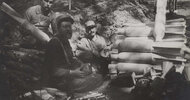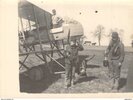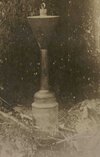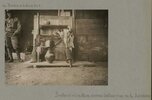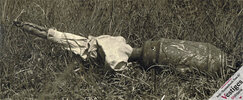There is a lot of confusion on the Aasen bombs used by the French Aeronautique militaire in 1914-1916. Even the Article by Henry Belot on the Aasen grenades falls into some traps such as mixing the 1.7kg A2 Aasen grenade with the 3kg Aasen bomb.
In 1913 in Morocco they had used the same infantry Aasen grenade type A2 as the Italian had done in Lybia in 1911-12.
With an overall weight of 1.6 to 1.7 kg (depending of the content of explosive: either 260g of ECHO or 380g of Trytol) and including 140 metal balls of 3.3g each, Its metal sheet body had a diameter of 80mm and height of 150mm. The overall length including the wooden handle was 330mm. To the handle was attached an inverted fabric umbrella for stabilizing the fall (and originally for helping the infantry soldiers to throw it)
The Type C and its French clone the excelsior-Thevenot P2 do not seem to have been used by airmen due to their smaller weight and explosive power.

Now the 3kg Aasen bomb - officially designed as "type D", also known as "Aircraft type" - apparently introduced end 1914, its dimensions seem (according to the only photograph I could find of it, on the lexpev site, sadly of low quality) to have been roughly the double of the A2 ones. It included 400 metal balls inside of the original 140 of the A2.

Above, from left to right: Type A , Type A deployed , Type A2 , Type A4 , Type B , Type C , aircraft design ("Type D") , rifle grenade
Then we have then mysterious 10kg "high capacity" or "enlarged" Aasen bomb that appears recurrently in the Operational Reports of ww1 French Squadrons in 1915.
I have found in these records more an more elements that lead me to strongly suppose this bomb is no other than the second, smaller and almost cubic, type of "square bomb" I posted in another recent thread.
This includes the repeated mentions of "bombe carree de 10kg" in reports from the period (such as:
"Les vols emouvants de la guerre" dated 1917, and "La guerre illustree" from 1919)
The evolution between the fabric umbrella and the "Italian-type" stabilizing stub is quite straightforward (though the original development may in fact have been Austro-Hungarian, before the Italian picked the idea - I'll post an interesting pic I found lately on this at some later time).

In short...who can help to put some more flesh on this skeleton - more details, pics etc...
In 1913 in Morocco they had used the same infantry Aasen grenade type A2 as the Italian had done in Lybia in 1911-12.
With an overall weight of 1.6 to 1.7 kg (depending of the content of explosive: either 260g of ECHO or 380g of Trytol) and including 140 metal balls of 3.3g each, Its metal sheet body had a diameter of 80mm and height of 150mm. The overall length including the wooden handle was 330mm. To the handle was attached an inverted fabric umbrella for stabilizing the fall (and originally for helping the infantry soldiers to throw it)
The Type C and its French clone the excelsior-Thevenot P2 do not seem to have been used by airmen due to their smaller weight and explosive power.
Now the 3kg Aasen bomb - officially designed as "type D", also known as "Aircraft type" - apparently introduced end 1914, its dimensions seem (according to the only photograph I could find of it, on the lexpev site, sadly of low quality) to have been roughly the double of the A2 ones. It included 400 metal balls inside of the original 140 of the A2.

Above, from left to right: Type A , Type A deployed , Type A2 , Type A4 , Type B , Type C , aircraft design ("Type D") , rifle grenade
Then we have then mysterious 10kg "high capacity" or "enlarged" Aasen bomb that appears recurrently in the Operational Reports of ww1 French Squadrons in 1915.
I have found in these records more an more elements that lead me to strongly suppose this bomb is no other than the second, smaller and almost cubic, type of "square bomb" I posted in another recent thread.
This includes the repeated mentions of "bombe carree de 10kg" in reports from the period (such as:
"Les vols emouvants de la guerre" dated 1917, and "La guerre illustree" from 1919)
The evolution between the fabric umbrella and the "Italian-type" stabilizing stub is quite straightforward (though the original development may in fact have been Austro-Hungarian, before the Italian picked the idea - I'll post an interesting pic I found lately on this at some later time).
In short...who can help to put some more flesh on this skeleton - more details, pics etc...
Last edited:








